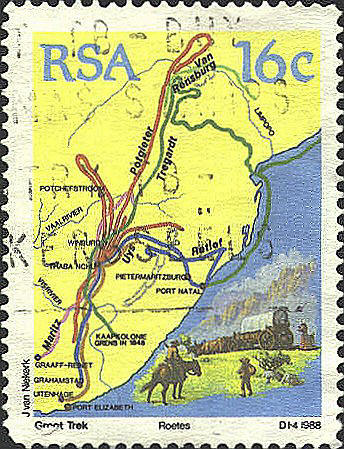|
In 1835 because of
economic problems, the danger of conflict with the Xhosa, and
primarily, discontent with the English colonial authorities who had
forbidden the slave trade and postulated the equality of whites and
non-whites, more than 10,000 Boers, the Voortrekkers, left the Cape
Colony with their famiies and went north and north-east.
A camp of 5,000 Voortrekkers gathered at ThabaNcho in
what would eventually become the Orange Free State. There they
;neogitiated with the Zulus for land in south and central Natal. But
the Zulus attacked them and killed about 500 of them.
Under the leadership of Andries Pretorius they defeated
the Zulus in the Battle of Blood River on December 16, 1838. They
founded the Boer Republic in Natal with Pietermaritzburg as its
capital. However, in 1842, British troops occupied Port Natal, today's
Durban, and annexed the Republic as a Crown Colony.
The stamp shows the routes of several groups of
trekkers from the Cape Colony north. The groups are identified by the
names of their leaders, Maritz, Potgleter, Van Rensburg, Tregardt,
Uys, Retlef.

On November 15, 1899
Winston Churchill, a correspondent for the Morning Post, was
taken prisoner at the Blauw Krantz River by the Boers. On December 12
he climbed a wall of the prison in Prtoria and escaped. A reward of
£25 was offered for his capture dead or alive. Eleven days later he
arrived in Durban. The map on the souvenir sheet shows the route of
his escape. He returned to London and wrote two books on the war:
From London to Ladysmith via Pretoria and Ian Hamilton's March.
Both these books first appeared in 1900 while the war was still in
progress.

 |
